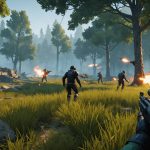Unlocking Fear: Leveraging Adaptive Audio Techniques to Deepen Player Immersion in Horror Games
The Power of Audio in Horror Games
When it comes to crafting an immersive horror experience, few elements are as crucial as the audio design. Audio can elevate the tension, enhance the narrative, and make the player feel like they are an integral part of the horror story. In this article, we will delve into how adaptive audio techniques are used in horror games to create a more immersive and terrifying experience.
The Role of Sound in Horror
Sound is a fundamental component of horror games, often more so than visual elements. It can create an atmosphere of dread, make the player anticipate danger, and even manipulate their emotions. For example, in games like Until Dawn, the sound design is meticulously crafted to keep players on edge. Jason Graves, the composer for Until Dawn, used film music editing techniques to create a dynamic soundtrack that adapts to the player’s actions. He divided each track into segments and manipulated the recordings to introduce variations, ensuring the music responded to the player’s choices in real time[1].
Have you seen this : Unlocking AI”s Potential: Crafting Personalized In-Game Tutorials for New Players
Adaptive Audio Techniques
Adaptive audio techniques involve adjusting the audio in real time based on the player’s actions and the game’s state. This can include changing the music, sound effects, and even the dialogue to match the player’s progress and decisions.
Dynamic Soundtracks
A dynamic soundtrack is one that changes based on the player’s actions. In Until Dawn, the Decima game engine was programmed to layer music depending on the player’s choices, creating a unique audio experience each time the game is played. This approach ensures that the music is not just a background element but an active participant in the storytelling process.
Have you seen this : Enhancing Multiplayer Survival Games: Innovative Ways AI Boosts Player Engagement
| Game | Adaptive Audio Technique | Impact on Immersion |
|
|-----------------------------------------------|
|
| Until Dawn | Dynamic soundtrack based on player choices | Enhances tension and reflects player decisions |
| Silent Hill 2 Remake| Real-time audio adjustments based on player actions | Increases fear and anticipation |
| Layers of Fear | Environmental sound changes reflecting the Painter's history | Creates a haunting and personal experience |
Real-Time Audio Adjustments
Real-time audio adjustments can significantly enhance the gaming experience. For instance, in the Silent Hill 2 Remake, the audio is adjusted in real time to reflect the player’s actions and environment. This includes eerie and off-putting sounds that resonate through the environment, making the player feel the presence of enemies even when they are not visible[5].
Crafting Interactive Storytelling
Interactive storytelling is at the heart of modern horror games. By allowing players to make choices that impact the narrative, these games create a sense of ownership and immersion that traditional media cannot match.
Player Choices and Consequences
In Until Dawn, the player’s choices are central to the story. The game features a butterfly effect mechanic where every decision, no matter how small, can lead to different outcomes. This mechanic is supported by adaptive audio that reflects the player’s choices, making each playthrough unique and personal[1].
The Impact of Collaboration on Audio Design
Collaboration between different teams within game development is crucial for creating an immersive audio experience. Here’s how different teams come together to craft a terrifying audio visual experience.
Collaboration Between Composers and Game Designers
In the development of Until Dawn, the composers and game designers worked closely together to ensure that the music and sound effects were perfectly aligned with the game’s narrative and player actions. Jason Graves, the composer, used film music editing techniques to create a soundtrack that was both haunting and adaptive. This collaboration resulted in a game where the audio is not just an accompaniment but an integral part of the storytelling process[1].
User Experience and Feedback
Understanding the user experience and gathering feedback are essential for refining the audio design in horror games.
Using Feedback to Enhance Fear
The development team of Until Dawn used a galvanic skin response test to measure playtesters’ fear levels while playing the game. This feedback was crucial in ensuring that the game was scary enough and that the audio design was effective in invoking fear. By adjusting the audio based on this feedback, the team could fine-tune the game to maximize the horror experience[1].
Examples of Effective Audio Design in Horror Games
Several horror games stand out for their exceptional audio design, each using adaptive audio techniques in unique ways.
Until Dawn
Until Dawn is often described as an interactive horror movie, borrowing elements from classic horror films and games. The game’s audio design is remarkable, with lifelike characters, moody atmosphere, and a brooding musical score. The sound effects and music are designed to keep players on the edge of their seat, making every decision feel critical and every moment tense[2].
Silent Hill 2 Remake
The Silent Hill 2 Remake is another example of how adaptive audio can enhance the horror experience. The game’s audio is so intensely frightening that players often find it unbearable to play with the volume turned up high. The use of haptic feedback and immersive sound design makes the player feel the music and sounds through the gamepad, adding a new layer of realism to the game[5].
Layers of Fear
Layers of Fear is an art-based psychological horror game that relies heavily on audio visual elements to create a haunting experience. The game uses subtle changes in the environment to illustrate different parts of the Painter’s history, creating a deeply personal and terrifying narrative. The audio design is crucial here, as it helps players navigate the Painter’s descent into madness through visual clues and environmental sounds[4].
Practical Insights and Actionable Advice
For game developers looking to leverage adaptive audio techniques in their horror games, here are some practical insights and actionable advice:
Use Real-Time Audio Adjustments
- Adjust the audio in real time based on the player’s actions and the game’s state. This can include changing the music, sound effects, and even the dialogue to match the player’s progress and decisions.
- Use tools like the Decima game engine to layer music and sound effects dynamically, ensuring the audio responds to the player’s choices.
Collaborate Closely with Composers and Designers
- Work closely with composers and game designers to ensure that the music and sound effects are perfectly aligned with the game’s narrative and player actions.
- Use feedback from playtesters to refine the audio design and ensure it invokes the desired level of fear.
Focus on Immersive Sound Design
- Use immersive sound design techniques such as 3D audio and haptic feedback to make the player feel the music and sounds through the gamepad.
- Ensure that the sound effects and music are designed to keep players on the edge of their seat, making every decision feel critical and every moment tense.
Adaptive audio techniques are a powerful tool in the arsenal of horror game developers. By leveraging these techniques, developers can create an immersive and terrifying experience that draws players into the heart of the horror story. Whether through dynamic soundtracks, real-time audio adjustments, or close collaboration between composers and designers, the impact of adaptive audio on the gaming experience is undeniable.
As Jason Graves, the composer for Until Dawn, noted, “The music was divided into segments and manipulated to introduce variations, ensuring the music responded to the player’s choices in real time.” This approach not only enhances the narrative but also makes the player feel like they are an integral part of the story, deepening their immersion and fear.
In the world of horror games, where the line between reality and virtual reality is often blurred, adaptive audio techniques stand as a testament to the innovative and terrifying possibilities of interactive storytelling.











